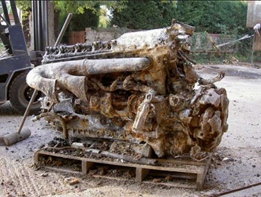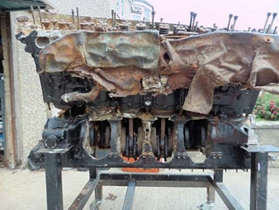Growing up in the 1970s, a highlight of the weekends as a young boy were the many black and white Second World War films shown in the afternoons. Particular favourites of mine being ‘633 Squadron’, ‘Mosquito Squadron’, and ‘The Dambusters’.
Building model aircraft kits was one of my hobbies at the time, my collection including the De Havilland Mosquito. This was an aircraft which, even at my young age, I recognised as one which had great elegance. A machine designed to fly as fast as possible, its smooth sleek outline without any unnecessary lumps, bumps, or add-ons to slow it down. As has been said many times, if something looks right, then it generally is right!
Living in Swindon, Wiltshire, the workshop town of the Great Western Railway, there was an inevitability that I would have an interest in railways, which would lead me into a career in which I remain today. My interest in aircraft, therefore, took a bit of a back seat for some years. However, what did retain my attention was whenever I heard the unmistakable sound of a Rolls Royce Merlin engine. There are few sounds which stir the emotions in the way that the roar of a Merlin does!
Early last year, whilst working in Lincolnshire, my interest in Mosquitos and Merlins was about to get re-awakened. Whilst idling away some time on the Internet in the Hotel, I saw an advertisement for a Merlin from a World War Two Mosquito for sale in the Derby area. Derby is somewhere midway between where I was working and home. I could go and have a look at it! But, to buy a Merlin? This was a crazy idea! A few hours of trying to reconcile with myself the reasons for and against and a phone call to my partner Tina to explain my crazy idea followed. Anyway, I did call in to see it on my way home, bought it, and on Friday 28 April 2017, Merlin 25, Serial No. 150969 arrived at my home …
Mosquito MM677
This aircraft was built at the De Havilland factory in Leavesden, Hertfordshire, being completed for service on 22 May 1944. A Night Fighter NFXIX fitted with two Merlin 25 engines and Airborne Interception Radar equipment built to contract No. 1576/SAS/C.23(a), it was one of 25 NFXIX Mosquitos built at Leavesden in May 1944. Delivery to 157 Squadron at RAF Swannington followed and the aircraft was given the Squadron Code: RS-U.
Merlin 150969 A439943
Merlin 25 with Single stage, two speed super-charger. Reverse flow cooling. Produced at the Rolls Royce factory in Hillington, Glasgow. Build commenced on 20 January 1944, and the engine was despatched one week later, on 27 January. The early history of this engine is not known, but it was returned to Rolls Royce at Bilborough for overhaul in October 1944, being despatched to 25 MU Hartlebury following the rebuild.
At some time between October 1944 and April 1945, this engine was fitted to the Port wing of MM677, coupled to a Nash Kelvinator propeller.
Flight Sergeant John Maurice Moore
Service No: 573817
Son of William Robinson Moore and Ruth Hannah Moore, of Bassenthwaite, Cumbria, John trained at Virden, Manitoba, Canada, on Cessna Cranes, before progressing to Airspeed Oxfords, Avro Anson, Bristol Blenheims and Bristol Beaufighters. At 51 OTU Twinwoods Farm, he was teamed up with his Navigator, Sergeant T. J. Westoby. In February 1945, he commenced Mosquito training. By 12 April 1945, he had amassed 526 flying hours, of which 41 were on Mosquitos.
Sergeant Trevor John Hunter Westoby
Service No: 1806456
Royal Air Force Volunteer Reserve. Son of Donovan Lord Westoby and his wife Gertrude Margaret of ‘St Ives’, Maypole Road, East Grinstead, and later of Burton’s Green, Essex. Joined the RAF in 1943 and trained in Canada.
5 APRIL 1945
Bad weather forced an early cancellation of operations at RAF Swannington, so the opportunity was taken for a football match in the afternoon, Ground Crew v Air Crew, which Ground Crew won 4-0. A Squadron party followed in the evening.
Two crews arrived from 1692 BSTU –
F/Lt J. W. Mawe
F/Sgt R. D. Keefe
F/Sgt J. M. Moore
Sgt T. J. Westoby
10 APRIL 1945
At 20:48hrs, with Belgian Pilot F/O Vermeulen at the controls and F/Sgt Hersh navigating, MM677 took off from RAF Swannington on a high-level escort mission to Dessau. They were accompanied two minutes later by RS-T, NT382. Both aircraft returned safely at 01:30 and 01:17 respectively. This was to be the last operational flight of MM677.
12 APRIL 1945
In the morning, there was a long lecture for Navigators by F/Lt D. Bunch DFC.
At 14:26hrs, F/Sgt J. M. Moore and Sgt T. J. Westoby took off from RAF Swannington in MM677 on an authorised night-flying test in company with another Mosquito of 157 Squadron: NT379, RSQ piloted by F/Sgt K. W. Crane with F/Lt R. J. V. Smythe as his Navigator. The two aircraft climbed to a height of 11,800ft and flew on a southerly course with MM677 approximately 250yds in front of NT379.
At 14:56hrs, MM677 carried out a ‘peel off’ to Port, the following crew immediately lost sight of them and gave chase. When they next saw MM677 two or three seconds later, it was approximately 2-3,000ft below them. They had the impression it was on fire. It then entered cloud and they lost sight of it. They descended through the cloud and saw the wreckage.
F/Sgt J. M. Moore and Sgt T. J. Westoby both died in the crash, their bodies being found in the wreckage. They were both just 22 years old and had only been with 157 Squadron for one week.
The official Report into the accident states as its conclusion:
‘The primary cause of this accident appears to have been over-stressing the aircraft. Contributory factors may have been the flying with a full fuselage fuel tank and flying a Mk XIX Mosquito without the 5lb inertia weight in the elevator control system.’
It is a sobering indication that, by this late stage in the war, people had become so hardened and accustomed to tragedies of conflict, that the remains of the aircraft were rapidly buried in the ground or unceremoniously removed to allow the ploughing to continue that was in progress when the aircraft crashed.
THE REMAINS OF MM677
MM677 lay buried in the Norfolk soil for the next four decades until they were re-discovered and subsequently excavated by members of the East Anglian Research Group. I have been unable so far to find out much information regarding the recovery of the wreckage or the locations of any other parts of MM677 recovered from the crash site.

Port Side, immediately following excavation (photo copyright: EARG)
The engine impacted the ground on its Starboard side, causing significant damage. The Port side was relatively undamaged as can be seen from the picture (left). Also visible is the ‘saxophone’ exhaust system fitted to night fighter Mosquitos to reduce flames from the exhaust, which would otherwise make them visible to enemy aircraft. The supercharger and carburettor were ripped from the engine in the impact.

Over the years, the wet Norfolk soil has found its way inside the engine, filling the inlet manifolds and cylinder heads. Many of the steel parts have severely corroded, while the majority of moving parts have seized solid. To prevent the engine from deteriorating further, I am gradually and carefully dismantling it, removing as much of the mud and Starboard Side, showing impact damage, corrosion as I can. The engine will then be re- (engine partly dismantled for restoration) assembled using as many of the original parts as is possible. It will unfortunately never run again, as to do so would require the replacement of so many components that it would eliminate the history of the engine
Alongside the restoration of the engine, I have been carrying out research into the aircraft and its crew, their Squadrons and operations – a fascinating and open-ended process, leading me to new and interesting discoveries, places and people. Most importantly however, it is ensuring that the history and sacrifice of these brave men and women is not forgotten or lost in the passing of time, and is preserved for future generations.
by Martin Rouse
This article is from the Spring 2018 issue of Confound and Destroy